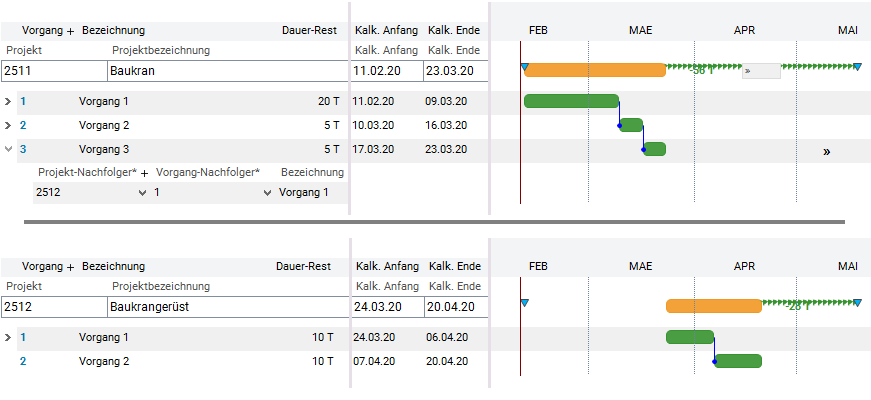Behavior of Scheduling in Project Structures
Information
- PLANTA project always includes the currently selected project and its subprojects during scheduling. This is done regardless of whether the subprojects are selected and displayed.
- If the top project is selected, the entire project structure is scheduled by PLANTA project.
- If a subproject is selected, it is scheduled by PLANTA project including its subprojects.
- After projects have been structured and the schedule has been calculated, a structure task is created automatically in each parent project. A structure task is a task which connects a parent project to a subproject.
- Durations, effort, and costs are summarized from the subproject to the structure task of the parent project.
Control Data Exchange between Main Project and Subproject
Information
- When planning with project structures, the data exchange between different project levels can be controlled via the Structure calculation with adjustment model parameter.
Notes
- If model parameters are changed in the project structures area, the entries in Planned duration, Requested start, and Requested end must be checked and corrected if necessary.
- For cost calculation purposes you are advised to enter effort and costs only at one level, like e.g. the subproject level. Entry at both structure task and main and subproject level should be avoided.
- The standard modules do not contain these data items for structure calculation. If you want to have them displayed, the following data items can be included in the modules individually:
- DI001123 Structure start , DI001124 Structure end , DI001140 Planned duration/structure , DI001141 Actual duration/structure , DI001142 TA Remaining duration/structure , DI001143 Planned duration/structure DI001143 Remaining effort/structure , DI001144 Actual effort/structure , DI001145 Remaining effort/structure , DI001633 Planned costs/structure , DI001634 Actual costs/structure , DI001635 Remaining costs/structure DI001636 Total costs/structure
- The actual start date is not automatically set for structure tasks with subprojects.
SF and FF Links for Structure Tasks
Objective
- To show the effects of SF and FF links on structure tasks
Information
- When carrying out the calculations for project structures, the key dates for the parent task (e.g. TA Earliest start and TA Latest end, depending on the model parameters) are copied to the subproject as its PR Requested start and PR Requested end, so that the subproject can run between these key dates.
- However, in the case of SF and FF links between structure tasks, their TA Earliest start is not known until the calculations are completed for the subproject, which is why these dates cannot be passed down before that point. Thus, there is a chicken and egg problem which causes some other PM systems to simply ban such links. In PLANTA project, SF and FF relations between structure tasks are possible. They are taken into account as follows:
- The TA Requested start of the subproject the parent task of which is a successor of a SF or FF relation, is determined from:
- the project start date of the higher level project, if there are no other SS or FS links pointing to this task.
- the TA Earliest start of the parent task, if it is the successor of an FS or SS link.
- All tasks which have no successor are moved just far enough so that the SF and FF links are complied with.
- The TA Requested start of the subproject the parent task of which is a successor of a SF or FF relation, is determined from:
Taking into Account of Cross-Project (External) Links during Scheduling
Information
- The interlinkage of projects via links results in the generation of a total network plan covering all projects involved. Any projects which have cross-area links to the project selected by the user will automatically be included in the calculation. Here, own project dates (PR Requested start /Requested end, PR Actual start/Actual end) and project priorities will be taken into account.
Calculation sequence of the projects
- During replanning, the cross project links override the calculation sequence. It may occur that a project with bad priority is calculated earlier due to the existence of a cross-project link.
Example
- Cross-project links between different main projects
- There is a cross-project link from task 03 in project 2511 to task 01 in project 2512.

- Result of scheduling
- TA 01 in Project 2512 cannot take place until after TA 03 in Project 2511 is finished. When the calculations are being performed for Project 2512, Project 2511 will automatically be calculated at the same time. Although the project priority for project 2511 is less urgent, tasks 01 to 03 will be loaded before task 01 from project 2512.

Determine the Rank of a Task with Cross-Project Links
Information
- The rank of a task which has a cross-project predecessor is determined as the maximum of its rank within its own project, and the rank of its cross-project predecessor.
Example
- Project A has tasks A1, A2, A3, A4, and Project B has tasks B1, B2, B3; both projects have the same priority.

- Task (B2) has rank 2 within its project, its cross-project predecessor (A3) has rank 3 within its respective project. As a result, task B2 is given the rank 4 within the Total Network Plan. The rank of its successor will be 5.
- The loading sequence is: A1, B1, A2, A3, A4, B2, B3.

Example
- If project B has a less urgent priority, then task B1 receives rank 3.

- Loading sequence, taking into account the project priority: A1, A2, A3, B1, A4, B2, B3.
-
Page:Structure Project / Subprojects (PLANTA project/portfolio)